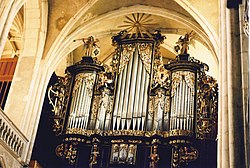Organs of the parish church of Sibiu
The organs of the parish church are four historical and modern instruments in Hermannstadt , in Romanian Sibiu , in Transylvania . The main organ was built by W. Sauer from Frankfurt (Oder) in 1914/1915 and is the largest in Romania with 78 (71) registers on four manuals and a pedal . The prospectus from 1672 by Johann Vest is the oldest preserved in Transylvania.
A positive by Johannes Hahn from 1748 has six registers, an organ from the Emil Hammer Orgelbau workshop from 1969 has seven registers on two manuals and pedal and another positive from 2001 by Hermann Binder from Sibiu has four registers.
From 2018 to around 2021, only the positive from Johannes Hahn can be heard in the Ferula, a side room of the church. The other instruments are packed or removed from the church for renovation work.
Main organ
| Organs of the parish church of Sibiu | |
|---|---|
| General | |
| alternative name | Sauer organ |
| place | West gallery |
| Organ builder | Orgelbauanstalr W. Sauer Frankfurt (Oder) |
| Construction year | 1914-1915 |
| Last renovation / restoration | 1926, 1932, 1936, 1940, 1997 |
| epoch | 20th century |
| Organ landscape | Brandenburg, Transylvania |
| Illustrations | |
| Technical specifications | |
| Number of registers | 71 + 7 transmissions |
| Number of manuals | 4th |
history
First organs
The first information about an organ in the city church in Sibiu was received from 1350.
From 1671 to 1672 the organ builder Johann Vest from Bartfeld in Upper Hungary built an organ with 40 registers on two manuals and a pedal, which was the largest in Hungary at the time. The case has been preserved, as probably the oldest in Transylvania, as are some 16 'pewter prospect pipes.
Sauer organ from 1914/1915
In 1914 there was an international tender to build a new organ. 40,000 guilders were made available for this. This was carried out by the Wilhelm Sauer Frankfurt (Oder) company, which was owned by Paul Walcker from Ludwigsburg at the time. It was inaugurated at Christmas 1915 by the organist Johann Leopold Bella and other contributors. With 71 registers, 7 transmissions, four manuals and pedal, it was the largest in Hungary and one of the company's first with electro-pneumatic action.
In 1916 the electric actions were improved, in 1932, 1936 and 1940 further repairs took place, during which the disposition was changed.
In 1997 Christian Scheffler's organ building workshop from Sieversdorf in Brandenburg carried out extensive restoration work. The disposition was brought back to the status of 1915. Most of the work was paid for by the Federal Ministry of the Interior of the Federal Republic of Germany.
During the extensive renovation work in the church from 2018 to probably 2021, the organ is packed up and cannot be played. Then it will be cleansed and heard again.
organ
The organ has 78 registers, including 7 transmissions in the pedal, four manuals and pedal. The playing and stop actions are electro-pneumatic. The console is about 10 meters away from the organ on the south pore. It has 14 wind chests, including one with high pressure (135 mm).
Positive from 1748
In 1748 Johannes Hahn built a positive for the Protestant church in Michelsdorf (Romanian today Boarta). This came to the auditorium of the Brukenthal School at an unknown time, where it remained until 1948.
In 1988 the instrument was moved to the south pore of the Herrmannstadt parish church and restored by Hermann Binder's organ workshop . Another overhaul by Binder took place in 2008/2009. During the renovation work in the church, it can be heard from 2018 to around 2021 in the ferula , a side room of the church.
Sound recordings
- Sauer Organ Youtube
- Sauer Organ Youtube
literature
- The Sauer organ in Sibiu (= architectural monuments in Transylvania). Monumenta Publishing House, Sibiu 1997.
- Hermann Binder : Organs in Transylvania (Orga în Ardeal). GMV, Kludenbach 2000.
Web links
- Sauer-Orgel Organ file of the Evangelical Church AB in Romania
- Hahn-Orgel Organ file of the Evangelical Church AB in Romania
- Hammer-Organ Organ file of the Evangelical Church AB in Romania
- Binder organ Organ file of the Evangelical Church AB in Romania

